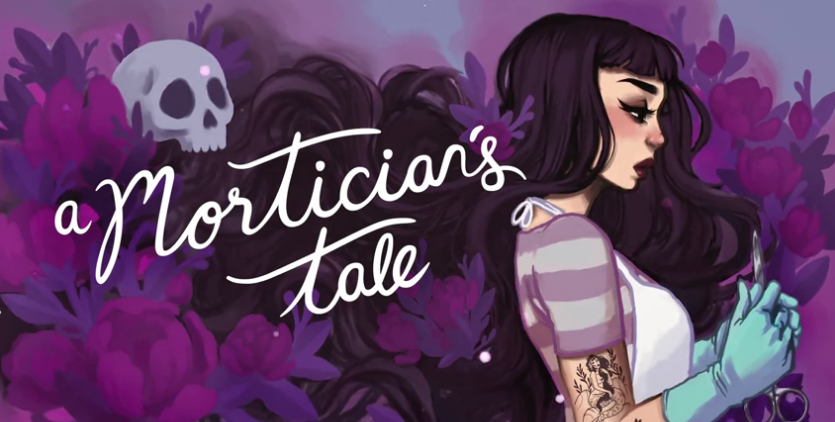
For our Rogues Portal readers, can you tell us a little about A Morticians Tale?
Sure! A Mortician’s Tale is a narrative-driven, death positive video game where you play as a mortician tasked with running a funeral home.

A Mortician’s Tale follows recent funeral direction graduate Charlie at her new job at a family-run funeral home called Rose and Daughters. In the game you’ll be tasked with interacting with Charlie’s desktop, reading her emails from coworkers, clients, bosses, etc., preparing the bodies of the deceased for burial or cremation, and attending their respective funerals and listening to their loved ones’ stories. As you progress through the game, you’ll see how Rose and Daughters funeral home changes overtime too.
A Mortician’s Tale is an informative, honest, and sometimes humorous look at the current state of and the future of the western death industry.
My uncle used to work in a funeral home, so I spent a good year there. This game hit me right in the feels, especially with talking to the families and paying respects (Thank you so much for this game.) What motivated you to create a death positive game? It’s something that’s definitely needed, but very underground and not talked about a lot.
Thank you so much for the kind words about the game!
I have a few friends who either currently or previously have worked in the death industry. I’ve always been interested in their work. I knew I wanted to make a game inspired by their experiences. It wasn’t until after reading Caitlin Doughty’s book Smoke Gets in Your Eyes that I felt inspired to do it.
Smoke Gets In Your Eyes is a fascinating and often humorous autobiography where Caitlin talks about her career as a mortician and the history of the western death industry. I was first introduced to the concept of “death positivity” through her book. Which sounds like a bizarre term, but really it’s a movement that encourages people to be open to talking about death, and to explore their fears of grief and mortality. It’s not meant to erase feelings of grief or loss, but to instead be open to understanding it, and discussing it. Ultimately being comfortable with talking about death allows us to make informed decisions for both ourselves and our loved ones.
I resonate with this idea of “death positivity” a lot. Caitlin’s story about going from working in a crematorium to attending funeral direction school, to running her own green funeral home, are what really inspired the story of A Mortician’s Tale.
Caitlin Doughty was credited as being a huge inspiration to the game. What about her and her death positive movement inspired you? She even looks like Charlie! Did you have the opportunity to work with her for the game?
Ahh, I guess I answered some of this already above haha.
Caitlin and her group The Order of the Good Death — a group made up of death professionals, academics, artists, and death positive activists — were hugely supportive of the game. We consulted with many Order members during the development of A Mortician’s Tale and adjusted the game based off their feedback.
The Funeral Monthly newsletters were a standout to me during the game. It highlights things you should avoid, think about and even different funeral practices for LGTBQ+ funerals and more. Why did you want to include those within the game?
There were many death-related topics we wanted to talk about in the game but couldn’t find good places to fit them. The majority of the interactions in the game come from reading through Charlie’s emails on her desktop between her bosses, friends, and coworkers, or listening to the deceased’s loved ones at their respective funerals, and talking about specific topics like green burials or water cremation didn’t quite fit. We decided to include a series of newsletters that would highlight the various death topics we wanted to talk about, in an educational / informative manner.

The benefit of the emails and interactions in A Mortician’s Tale is that they’re all optional. You don’t have to read anything if you don’t want to. So the Funeral Monthly emails give players interested in learning more about the death industry the option to do so, while leaving room for other players to skip them.
Another highlight is Jen Love, the best friend of Charlie. She is a wonderful constant friend and even tries to get her to date. Does she act as a bridge between the job and real life? She seems like an external resource for Charlie to just breath with.
Jen Love has gotten some serious love (no pun intended) from players of the game — and I agree, she’s hilarious and amazing. This is actually a better question for Kaitlin Tremblay, the writer of A Mortician’s Tale! She’s the one who came up with the character and wrote all of her dialogue.
One of the big changes in the game is the change within the funeral business. Rose and Daughters gets brought out by the Hillside Overlords and significant money changes that changes the dynamic of everything. Why was it important to tell this story as well? (I love Matthew’s sassiness towards them omg.)
I’ve heard so many horror stories from my mortician friends about some of the practices they’ve witnessed being taken on in larger funeral homes. I think often we forget that it is a big business, and we couldn’t make a game about it without discussing some of the shadier things that happen sometimes.
I don’t think Hillside is necessarily “shady” per say, but playing through the game you do see that their motivations are very business-focused, and that feels really cold.
Charlie’s full circle transition into her beautiful space is so rewarding! If you continue the game or perhaps expand, where would you go with Charlie’s adventure?
We currently have no plans to do any sequels or DLC for the game — we’re happy with the story we’ve told for Charlie. I think it’s sometimes best to leave it as is. That being said, there are a bunch of things we thought about including in the game that we ultimately decided to leave out. If we ever did any spin-offs, I’d love to explore some of that further.
One of the ideas we had is preparing a body that had been autopsied — that is, a body that had a suspicious death and had been to a coroner, before being brought to your funeral home. The process behind that is really fascinating but ultimately didn’t fit within the narrative of A Mortician’s Tale, so we opted to leave it out.
Cute little question: If you could have your own funeral home, what would you name it and what kind of services would you provide?
Honestly, Magnolia Forest — the funeral home at the end of the game — is my dream funeral home. It’s based off of Caitlin Doughty and her business partner Amber Carvaly’s own funeral home Undertaking LA, which focuses on supporting families through home funerals and offering green burial spaces and cremation services. It’s all super cool, and they’re the loveliest humans.
What was that process like for you as the game designer? Can you tell us a little bit of what that entails? Were there any challenges you had to face while designing the game?
The game went through quite a few changes before getting to where it is now. Originally, I had envisioned the game to be about a mortician who works on the bodies of deceased video game characters, preparing them based off their individual deaths. The game was endless, a very ham-fisted nod to the lack of permanence in most video games. Ultimately I decided to move away from that because I wanted to explore the career of a mortician, and this idea of a game focused on video game deaths moved away from that.

After that, I thought about having the protagonist Charlie have more speaking roles and had dialogue options for when she talked with her coworkers and bosses, and the deceased’s loved ones. The game also had fail states. Meaning you could say the “wrong thing” to a loved one and the game would change depending on how successful you were. I ultimately decided to remove this for a few reasons. The main one being that we wanted the game to be focused on listening rather than speaking. Secondly, we wanted Charlie to act as a silent vessel, allowing the player to insert themselves into the game. Death and grief are such personal things that differ from person to person, and forcing players to follow a specific character narrative felt counter-intuitive to the game’s themes.
Ultimately, I knew what I wanted A Mortician’s Tale to be. That meant reiterating on its design to make sure the game supported that vision. For a death positive game about the life of a mortician, this leads to A Mortician’s Tale becoming a thoughtful, slow, almost meditative narrative-focussed game. From there it was important to design it so that the game’s mechanics and aesthetic supported its narrative.
Do you have any advice for future game designers out there?
It’s important to think about your game’s focus or “pillar” and design everything else in the game to support it. If your game is narrative-focused like A Mortician’s Tale, it’s important that your mechanics, art, sound, music, etc. all work to reinforce that narrative. Same goes for games that are mechanics-focused, art-focused, etc. Think about every successful game and what its pillar is, and how the rest of the game supports it, then evaluate your game, find its pillar, and work to design the game so that it supports it.
Where can we find you? Via social media, website or any other way to connect?
A Mortician’s Tale Website: http://MorticiansTale.com
Laundry Bear Twitter: @laundry_bear
Personal Twitter: @gabdar
You can play A Morticians Tale now on Steam!



![[REVIEW] ANOTHER SUDDEN DEATH IN ‘BETTER CALL SAUL’ SEASON 6, EPISODES 6 & 7](https://geekd-out.com/wp-content/uploads/2022/05/bcs_s06e07_amc.0-150x150.jpg)